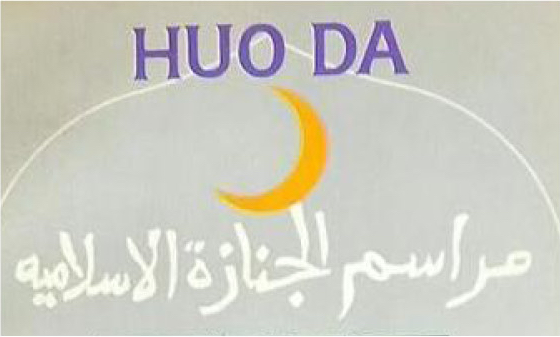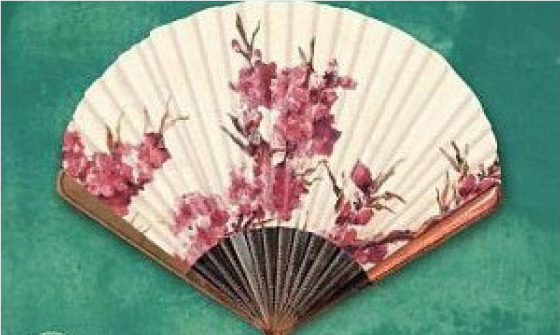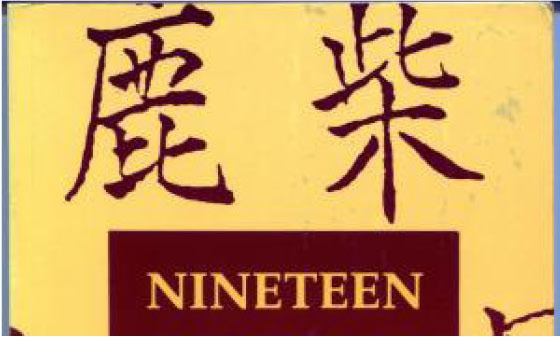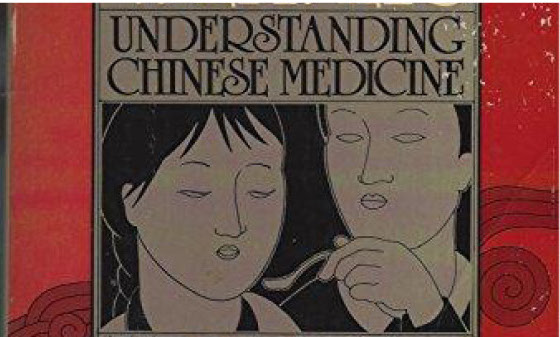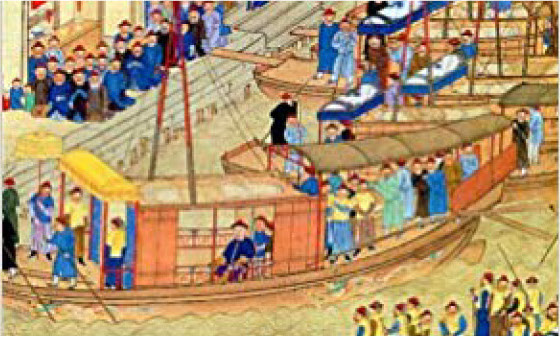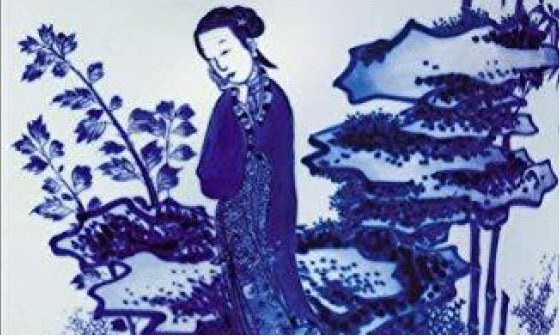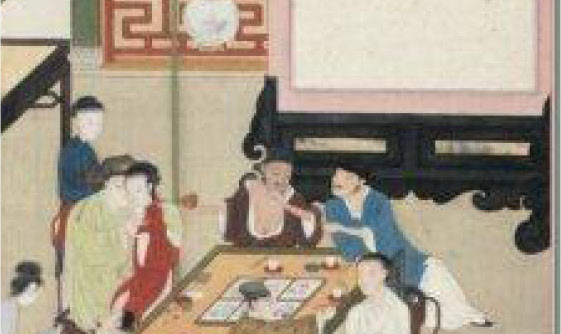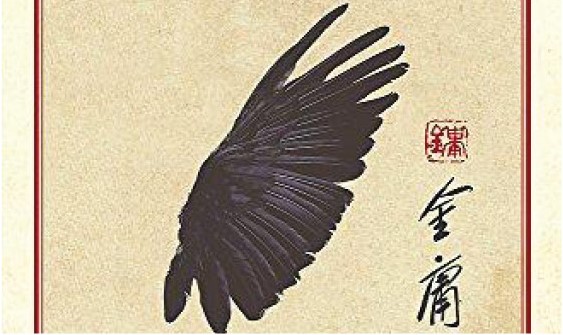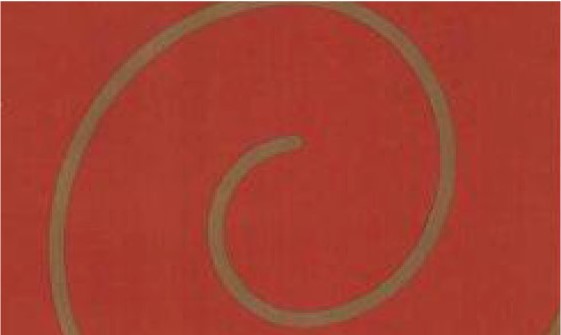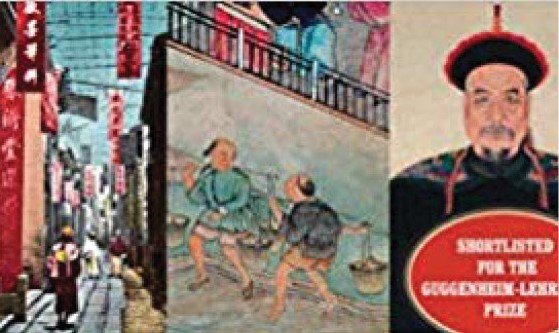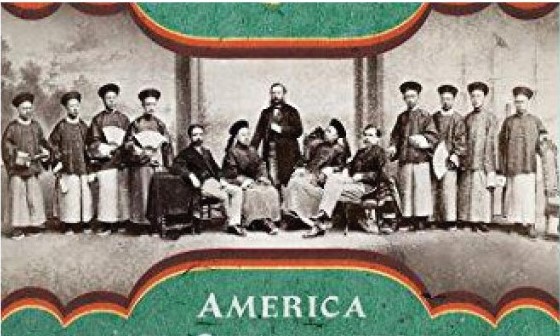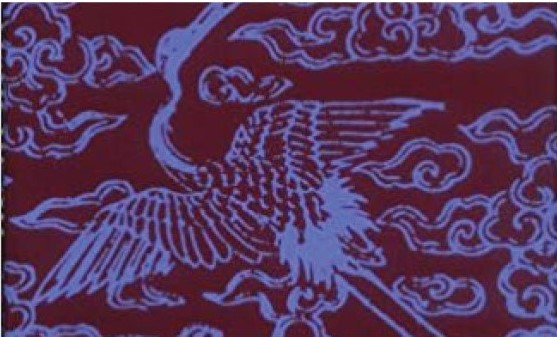The China Project Book List — time period: Ancient and Imperial China
Sort by genre:
Culture/Society/Memoir | Literature | History | Politics | Business/Tech
Sort by time period of primary subject matter:
Ancient and Imperial China | Republican Era to 1949 | Mao to Tiananmen | 1990s to Pre-Olympics | 2008-Present
~
95. The Jade King: History of a Chinese Muslim Family
Huò Dá 霍达, translated by Guan Yuehua (Panda Books, 1992)
It’s a sad fact that many important novels of the late-1980s and early-1990s, a golden age for contemporary fiction, remain untranslated, or received subpar or abridged translations. The Jade King, or Funeral of a Muslim, as the title is also sometimes rendered, is one of those books. Huo Da’s novel is a family epic based on her own upbringing as a Hui Muslim in China’s capital. The story of Han Ziqi, an orphan raised by Hui and tutored in the carving of jade ornaments, ranges from the late Qing Dynasty to the end of the Cultural Revolution, and from Beijing to London. Shortly after The Jade King’s release, it did receive an abridged translation, but the book remains virtually unknown in the English-speaking world, despite its enduring popularity in its home country, where it has won the Mao Dun Literature Prize, sold close to five million copies, and been adapted for film and television.
— Dylan Levi King
92. Snow Flower and the Secret Fan
Lisa See (Random House, 2005)
Snow Flower and the Secret Fan is an intricately imagined novel that seeks to portray the complex inner lives of two women during the Qing Dynasty. A subtly feminist work, at each major milestone in the lives of its two main characters, the author reminds the reader that for all the exotic trappings and social strictures of their time and place, women in Imperial China had their own voices, desires, and methods for exerting some measure of control over their lives.
The book follows the life of the narrator, Lily, beginning with her experience of footbinding in early childhood and, perhaps paradoxically, its role in helping her rise from the social class of her birth through an advantageous marriage. Footbinding is also Lily’s gateway to being instructed in “women’s script” (女书, nǔshū) — an actual writing system developed and used exclusively by women deep in Hunan Province — and, in turn, to being paired with a pen pal of sorts, the eponymous Snow Flower, who will become the single most important personal relationship of her long life. The book traces the experiences and written exchanges of these women as they navigate key life milestones and reflect on the ever-changing world beyond the seclusion of their “women’s quarters,” until the Taiping Rebellion and its aftermath threaten to overturn everything they know — including their deeply felt bond.
Snow Flower provides an important and humanizing glimpse into the lives of women in Imperial China, giving a lyrical voice to individuals who have otherwise been all too frequently overlooked.
— Siodhbhra Parkin
90. Nineteen Ways of Looking at Wang Wei: How a Chinese Poem is Translated
Eliot Weinberger (Moyer Bell Limited, 1987)
A quiet, wooded mountain; a glint of sunlight; a patch of moss. These are the components of ”鹿柴” (Lù Zhài), the poem that forms the subject of Nineteen Ways of Looking at Wang Wei (originally published in 1987, expanded and reissued in 2016). Wáng Wéi 王维 — an innovative painter, high-ranking court official, reluctant rebel, and devout Buddhist — sits alongside Li Bai and Du Fu in the triumvirate of great Tang Dynasty poets. Like their best-known works, Wang Wei’s poem has become a proving ground for many a generation of translators, and in this slender volume Eliot Weinberger collects a range of their efforts, dissecting them with fine-grained attention to detail and acerbic humor (Witter Bynner’s translation, for example, takes place in “a world where no statement can be made without a pregnant, sensitive, world-weary ellipsis”). Read Nineteen Ways of Looking at Wang Wei to appreciate the art of classical Chinese poetry, the practicalities of translation, and the subtle gradations of the English language.
— Dave Haysom
84. Cinderella’s Sisters: A Revisionist History of Footbinding
Dorothy Ko (University of California Press, 2007)
A self-proclaimed “alternative history” of the practice of footbinding in China, Cinderella’s Sisters is a gratifyingly challenging book. The premise is straightforward, if somewhat provocative: The dominant narrative of footbinding as a painful patriarchal practice imposed upon women for the pleasure of men is an ahistorical oversimplification — and one that serves to obscure the voices and experiences of the women at the heart of the story. In her complex book, which simultaneously serves as a social history, literary criticism, and study of material culture, Dorothy Ko seeks to “unwrap” footbinding in an effort to reveal the desires, motivations, and lived experiences of the women themselves who endured and to an extent drove the practice for the thousand or so years it persisted. While Ko, who teaches history at Barnard College, is careful to never fully condone or condemn footbinding, and does not shy from the unpleasant — and, as many would persuasively argue, brutal — realities of the practice, she does emphasize that for many Chinese women, bound feet were integral to their perceptions of dignity and self-worth. In this vein, Ko explores how different styles of footbinding emerged and flourished at different periods and locations, locating the various methods of breaking, bending, and binding the female foot within the more conventional history of Chinese fashion. Drawing on an array of sources, Ko thus convincingly seeks to dispel the perception of footbinding as a practice uniformly and unidirectionally inflicted upon women by men, and instead weaves a more complex tale that allows for an “open-ended space,” to use Ko’s phrase, in which the resilient voices of those whose feet were bound might finally find an audience.
— Siodhbhra Parkin
83. The Web That Has No Weaver: Understanding Chinese Medicine
Ted J. Kaptchuk, O.M.D. (Congdon & Weed, 1983)
First published in 1983, this book is a classic introduction to Chinese medicine that is equally well-suited for an acupuncture training course, a university philosophy class, or the bedside table of anyone interested in Chinese culture. Its author, Ted Kaptchuk, is a Harvard professor who studied traditional Chinese medicine (TCM) in Macau and is also known for his work on the efficacy of placebo effects in medical treatment. In addition to what you might expect from a guide to Chinese medicine — for example, explanations of various kinds and capacities of qi, pulse-taking, and careful comparisons of Chinese and Western notions of the body, illness, and healing — this book delves deep into the practical and philosophical roots of TCM, from the five aspects of the spirit to yin/yang oscillations to poetic (yet rigorous) meditations on landscape painting, the senses, and nature. Ultimately, this book is an ontological sketch of the Chinese universe. By taking this system of thought and practice and animating it for foreign readers, Kaptchuk challenges the notion that Western science has “a unique handle on the truth — all else is superstition.”
— Hanna Pickwell
79. The Man Awakened from Dreams: One Man’s Life in a North China Village, 1857-1942
Henrietta Harrison (Stanford University Press, 2005)
In this beautifully written work of local and personal history, author Henrietta Harrison provides a gentle yet compelling corrective to the tendency for books about China to focus on individuals and ideas with outsize impact. As she writes in the preface to this fascinating account about an ordinary man living an ordinary life in a tiny village in Shanxi Province, “Real humanity in historical accounts is all too often restricted to great leaders, famous writers, or original thinkers.” Without a trace of irony, she notes of the eponymous main character of her book: “Liu Dapeng was none of these.” Using the 400 or so volumes of personal diaries Liu left behind, Harrison paints a deeply human portrait of Liu and his family as they struggle to cope with the massive changes that gripped China in the late-19th and early-20th century. At the same time, Harrison artfully demonstrates how seemingly abstract developments such as the gradual shift away from Confucian ideology had immediate and deeply felt personal impacts. The Man Awakened from Dreams is therefore an important reminder that when it comes to a country as vast and complex as China, the best stories that teach us the most are not always the ones taken straight from the headlines.
— Siodhbhra Parkin
76. Imperial China 900–1800
F.W. Mote (Harvard University Press, 1999)
When it comes to English-language books on China, F. W. Mote’s Imperial China is as magisterial as it gets, taking on a broad canvas with confident strokes. Mote, who first went to China during World War II with the Office of Strategic Services (the CIA’s precursor), packs 40 years of scholarship into his work. By starting at the fall of the Tang and running through the high Qing, Imperial China has room to delve deeper than other general histories that aim for “5,000 years.” Mote makes the most of this decision, delivering narratives compelling enough to prompt frequent Wikipedia dives into his well-drawn characters, like standouts Liao Emperor Abaoji and reformist councilor Wang Anshi.
At its core, Imperial China is political history. Mote takes emperors and eunuchs to task for their failings, unafraid to judge leading characters for their decisions without undue deference to received historical tradition. He then makes his history relevant by grappling with challenges of governance applicable across ages. The book is particularly strong in two aspects: information on steppe peoples and elite political philosophy. It perhaps works best as a capstone for a 101 learner, bridging knowledge across dynasties and inspiring curiosity for deeper reading.
— Jordan Schneider
74. Six Records of a Floating Life
Shěn Fù 沈复, translated by Leonard Pratt and Chiang Su-Hui (Penguin Classics: Harmondsworth, 1983)
This is an early 19th-century book that crosses genres, blending memoir and novel to give us a portrait of a mid-level official and his relationship with his dear wife, who dies young. It’s a very accessible, short work, partly because four of the six records are lost. When I was first getting interested in China I read it and it sort of brainwashed me, in a very good way, making me realize the universality of ambition and disappointment, love and sadness, among people around the world. I feel that these kinds of books, which tell us about how people really live their lives, often in microscopic detail, are more lasting and telling than the usual “must-read” China books, which have a shelf life of a few years. They get under your skin and stick with you, which is what great writing should do.
For many Chinese readers, it’s also been an inspiring work. For example, the writer Yang Jiang used it as a loose template to record her time with her husband, the novelist Qian Zhongshu, in a labor camp (A Cadre School Life: Six Chapters).
— Ian Johnson
72. Disputers of the Tao: Philosophical Argument in Ancient China
Angus C. Graham (Open Court, 1989)
Disputers of the Tao is a marvelously sophisticated survey of the major streams of thought of pre-Qin China, how they emerge in response to the social-political environment and how they are in constant interaction with each other over time. As the title suggests, Graham reminds us that the notion of “Tao” was not particular to Taoists, but that each school of thought was working out its own Way. That is what they disputed: how should Tao be understood and practiced. The book is an excellent introduction to the differences between Confucius and Mozi and the Yangists and others. It clearly draws out distinctions between Confucius and Mencius and Xunzi. The Sophists and Zhuangzi are expertly analyzed. And it is fairly persuasive on a point that not everyone will accept: the nonexistence of a historical person, Laozi, the credited founder of Taoism. Surveys of this sort are difficult to pull off well without lapsing into textbook simplicity, but this one succeeds in both introducing basic concepts and also drilling deeply into fascinating philosophical, historical, and linguistic debates.
— Sam Crane
70. Décadence Mandchoue: The China Memoirs of Sir Edmund Trelawny Backhouse
Sir Edmund Trelawny Backhouse, edited by Derek Sandhaus (Earnshaw Books, 2011)
Sir Edmund Backhouse is a reflexively interesting character. He was a reclusive linguistic genius and an English dandy, the best-selling chronicler of the late-Qing Dynasty and a literary fraud, the alleged lover of Oscar Wilde and the Empress Dowager Cixi. Who wouldn’t want to read that autobiography? The two-odd years I spent decoding his handwritten memoirs — a dense thicket of polyglottal meanderings, contradictory claims, and byzantine literary allusions — were as mad and exasperating as any an editor is likely to encounter. But I wouldn’t have traded the experience for anything, because Décadence Mandchoue is a book unlike any other.
It is not a book for everyone. Many struggle to navigate its dense prose and baroque sexuality, and the line between reality and fantasy is blurred to the point of indecipherability. Yet readers who follow where its author leads — through the gay brothels of Qianmen, the seat of Manchu power, and the Forbidden boudoir — will glimpse a salacious but poignant portrait of a forgotten China.
— Derek Sandhaus
69. The Plum in the Golden Vase
Lánlíng Xiàoxiào Shēng 兰陵笑笑生, translated by David Roy (Princeton University Press, 1997)
The Great Learning (大学 dàxué), one of the Four Books of Confucianism and a cornerstone of late Imperial education, describes how morality and proper order radiate outward from a cultivated individual. Through self-cultivation, the Great Learning says, the ancients improved their minds, their persons, their households, and ultimately their country.
This is not what happens in The Plum in the Golden Vase (金瓶梅 Jīn Píng Méi). What happens in Jin Ping Mei is precisely not this. Unlike the other “masterworks of Ming fiction” (Three Kingdoms, Journey to the West, and Outlaws of the Marsh), which recount the heroic deeds of righteous heroes, Jin Ping Mei focuses on the squalid life of Xīmén Qìng 西门庆, a vulgar merchant who devotes his time, energy, and considerable wealth exclusively to the gratification of his own baser urges: his sexual escapades, described in exhaustive and increasingly unappealing detail, have earned Jin Ping Mei a reputation as an elaborately scandalous work of pornography. The rarity of good editions — the novel has been banned (with varying degrees of success) for most of the 400 years since its first printing, and unbowdlerized texts are still hard to find in the PRC — has probably contributed to this misunderstanding, as have the age and obscurity of the novel’s language and the magpie’s nest of allusions and quotations that make up much of the book. In fact, the sex scenes for which the novel is infamous account for less than 1 percent of the work as a whole, and seem to have been intended to complement the other perversions — of justice, of morality, of proper social order — that the anonymous author documents with the same pitiless clarity. Ximen Qing debauches, ravishes, and whores his way through much of the novel, but he also cozens, suborns, and climbs to heights of wealth and access that no one of his character or social status should ever have.
For an educated reader of the late Ming Dynasty, the conclusion of the novel — the collapse and dispersal of the Ximen household, juxtaposed with the fall of the Northern Song Dynasty to the Jurchens — would have come as no surprise, and not just because the Northern Song had ended five hundred years previously. Ximen Qing and his rapacity are symptoms, not causes, of a terminally sick society. Despite its Northern Song setting, which it borrows (along with its main characters and much of its first 10 chapters) from Outlaws of the Marsh, Jin Ping Mei is transparently about the late 16th century world in which its author and its first readers lived. The fashions, institutions, and characters are all straight out of the late Ming — the author’s eye for detail has made the book an important resource for historians of the period — as are the social ills it documents.
Imagine a world where the people in power are every bit as venal and corruptible as the merchants they officially despised. Imagine a state that imprisons and exiles the just. Imagine a society in such complete moral free-fall that the only imaginable goal is more. How long can it survive before the Jurchens show up? How long does it deserve to?
— Brendan O’Kane
67. To Live
Yú Huá 余华, translated by Michael Berry (Anchor, 2003)
Yu Hua is known for stories that capture an uncanny mix of comedy and tragedy in the lives of ordinary people in extraordinary circumstances. His seminal novel To Live chronicles the life of Xu Fugui, a hapless witness and participant in some of contemporary China’s most iconic historical junctures, from the tail end of imperial China through the Cultural Revolution. The scope and tone of the novel resembles Forrest Gump, another famous work of fiction whose titular character stumbles through decades of tumultuous change. To Live is a story full of heartbreaking tragedy that is deliberately devoid of maudlin sentimentality. By juxtaposing unadorned, matter-of-fact language against senseless horrors caused by rash decisions made by China’s political pantheon, Yu paints an extremely sympathetic portrait of China’s humble 老百姓 (lǎobǎixìng — “the people”), of their resilience and resignation. Though Fugui’s life is marred by loss and trauma, his capacity to accept the enormity of the suffering in his life will leave the reader in awe.
— Frankie Huang
61. A Hero Born: Legends of the Condor Heroes Vol. 1
Jīn Yōng 金庸 (pen name of Louis Cha Leung-yung [查良鏞 Chá Liángyōng]), translated by Anna Holmwood (Maclehose Press, 2018)
Jin Yong has had a greater influence on the literature and culture of the Sinosphere than any writer of his generation. His martial arts-driven wuxia epics earned the praise of literary theorists and his fellow writers (with the notable exception of Wang Shuo, who memorably beefed with Cha in the early-2000s), while also selling into the hundreds of millions of copies and winning a devoted following among politicians, gangsters, schoolchildren, and taxi drivers.
Anna Holmwood’s translation of A Hero Born, part of an expected set of four volumes, is a rare chance to read the author’s work. Set in the 13th century, the novel tells the story of two patriotic sons cast into exile in barbarian lands. With Cha’s identity as a mainlander in exile in Hong Kong, it was not hard to read political allegory into the book’s story of ethnic identity. Just as Chinese internet users reference characters and quotations from the Four Classic Novels to evade censorship while discussing contemporary politics, so too do they make allusions to Cha’s 15 novels — especially Legends of the Condor Heroes.
— Dylan Levi King
48. Banished Immortal
Hā Jīn 哈金 (pen name of Jīn Xuěfēi 金雪飞) (Deckle Edge, 2019)
Ha Jin’s The Banished Immortal is in a category all its own, uniquely illuminating on its subject, Lǐ Bái 李白 and his poetry, but Chinese poetry more generally and life in the Tang Dynasty too. Relying on original sources, including contemporary accounts, Ha Jin makes Li Bai come alive in all his ambition and restlessness, warmth, egocentrism, and dissipation — a flawed and complicated man who composed some of the most divine poetry ever written.
Before reading The Banished Immortal, I had never understood just how special and heartbreaking was Li Bai’s relationship with Dù Fǔ 杜甫 — considered alongside Li Bai as one of China’s greatest poets — or comprehended the desperate lengths Li Bai went in his quest for an appointment to the imperial court. It’s fascinating to read about how he frequently sabotaged his chances through egotistical posturing around the people whose help he craved. The Banished Immortal is a nuanced portrait of a complex man and his relationships with his wives, friends, fans, and the world around him more broadly. If Ha Jin exposes Li Bai’s flaws, he never diminishes his genius; his translations and commentaries on the poetry alone make this book a treasure.
— Linda Jaivin
42. Wandering on the Way
Chuang Tzu (Zhuāngzi 庄子), translated by Victor Mair (University of Hawaii Press, 1998)
This is a wonderfully idiosyncratic translation of one of Daoism’s foundational texts. Victor Mair believed that too many translations of Zhuangzi lose the whimsical and even comic nature of the original text, so he created a version that is lively and highly colloquial. It reads like a contemporary text, which is appropriate, given Daoism’s eternal themes about man and nature, philosophy and consciousness. And language: “A rabbit-snare is for catching rabbits; once you’ve caught the rabbit, you can forget about the snare. Words are for catching ideas; once you’ve caught the idea, you can forget about the words. Where can I find a person who knows how to forget about words so that I can have a few words with him?”
— Peter Hessler
31. Three Kingdoms: A Historical Novel
Luō Guànzhōng 罗贯中, translated by Moss Roberts (Foreign Language Press, 2011)
Said to be 70 percent history and 30 percent fiction, this riveting Ming Dynasty retelling of the events surrounding the fall of the once-great Han Dynasty deserves its place as one of China’s Four Great Novels (along with Dream of the Red Chamber, The Water Margin, and Journey to the West). Of the four, Three Kingdoms — we recommend the English translation of that name by Moss Roberts — arguably reveals the most about the Chinese political mind. It centers, in its first half, on the three sworn brothers Liu Bei (a distant relation of the embattled Eastern Han imperial family), Guan Yu (who would go on to be deified as the God of War), and the bruiser Zhang Fei, the Luca Brasi of the Three Kingdoms world. The cunning and ruthless Cao Cao; the brilliant strategist Zhuge Liang, and hundreds of other characters populate this tale. But peppered throughout the book are clever stratagems, subtle psychological manipulations, and feats of heroism and sacrifice. It’s really about how to govern, how to deploy talent, and how to wage war both on the field and in the mind. It’s this that makes the novel so enduring and memorable.
— Kaiser Kuo
27. Monkey
Wú Chéng’ēn 吴承恩, translated by Arthur Waley (The John Day Company, 1943)
Monkey is the book for those convinced they don’t like either Journey to the West (西游记) or its mercurial, rebellious, transdualistic smart-ass protagonist, Sun Wukong (a.k.a. the Monkey King, a.k.a. “Aware of Vacuity,” a.k.a. Great Sage, Equal of Heaven, a.k.a. Buddha Victorious in Strife…the list goes on). It is a picaresque, allegorical, compact folk novel full of notable characters from Chinese myth, from philosophers like Lao Tzu (Laozi) to beloved bodhisattvas like Kuan-yin (Guanyin). Is there adventure? Oh you bet. After upsetting a Peach Banquet and consuming magical fruits and pills, Monkey tussles with Buddha, wards off calamities, wields scimitars, claps back at immortals, lodges many-a-threats to cudgel fools upside the head, and eventually finds purpose with a band of misfits accompanying a monk on his journey to India.
What games are played, poems recited? What trouble befalls them? If you are interested in the answers, dear reader, listen to what is told in the next chapter.
— Anthony Tao
23. The Opium War: Drugs, Dreams and the Making of Modern China
Julia Lovell (Picador USA, 2011)
Utilizing extensive contemporary accounts and letters from participants, including the Emperor and British foot soldiers, Julia Lovell is able to capture the quasi-surreal “tragicomedy” of intransigence, self-deception, and slaughter that was the First Opium War. “Two and a half years after this war had started,” she writes, “[Chinese Emperor] Daoguang found himself still lacking the most basic information about his antagonists: Where in fact…is England?…How is it they have a 22-year-old woman for a queen? Is she married?” In the second half of the book, Lovell shows how the war, in many ways of little consequence at the time, would be used by Britain and U.S. for the next 150 years. Released in 2011, the sections about contemporary China read a bit dated, as 10 years ago feels nearly as foreign as the 1840s; still, the book is a compelling, comprehensive account of the war itself, and the war in the public consciousness that rages at all times across the world.
— Gabriel Clermont
20. The Beautiful Country and the Middle Kingdom
John Pomfret (Henry Holt and Company, 2016)
Early in John Pomfret’s wildly ambitious 700-page masterpiece on the history of U.S.-China relations is an observation that sets the theme for the entire book: “If there is a pattern to this baffling complexity, it may be best described as a never-ending Buddhist cycle of reincarnation. Both sides experience rapturous enchantment begetting hope, followed by disappointment, repulsion, and disgust, only to return to fascination once again.” Indeed, many of the characters throughout the nearly 250 years of U.S.-China interaction can be found today, from the idealistic missionaries seeking to “change China” to the Chinese students with American educations who return to become their country’s political and business elite.
And that’s what makes The Beautiful Country and the Middle Kingdom such a captivating read. Its thoroughly researched stories of riveting individuals throughout history put today’s U.S.-China relationship in much-needed context, particularly as that relationship falls under increased strain. Pomfret writes what is at its core a turbulent love story of two nations whose passions swing violently between desire and loathing. It’s a recipe for a dysfunctional relationship, but a relationship that defines our present and future — and one that makes for a fascinating book.
— Elliott Zaagman
18. 1587: A Year of No Significance
Ray Huang (Yale University Press, 1982)
If you’ve ever been in a museum in China and found yourself bored to tears by the endless displays of various earls and emperors’ furniture, robes, and other regalia, then here is a book for you. For in 1587, you will learn the truth about the late Ming Dynasty, which is that life in the imperial court was just as boring for the people who lived through it as it seems to us today. In Ray Huang’s telling, the Ming government was a doomed mess of foible and failure, like a 16th-century Veep. He describes the pomp and grandeur and pointless ceremony of imperial business with a kind of submerged dry wit: “The daily audience with the court, for instance, was loathed even by the most diligent statesmen.” But his thesis is a serious one: Ming society had become so paralyzed by elaborate rules, rituals, and moral constraints that it stifled whatever power any individual — even the Wanli emperor himself — could exert to arrest its decline. It’s a sad, sobering look at how things started going wrong for China all those centuries ago, especially at a time when the country’s current leaders have their own ideas about how to put things right.
— Ray Zhong
16. The Boxer Rebellion: The Dramatic Story of China’s War on Foreigners that Shook the World in the Summer of 1900
Diana Preston (Walker Books, 2000)
The Boxers — so-called because foreigners associated their brand of ritualistic calisthenics with pugilists — were impoverished and dispossessed northerners who launched an initially obscure peasant movement that turned murderous, with Western missionaries and Chinese Christians bearing the brunt of their attacks: “hacked to pieces, skinned alive, set alight, or buried still living,” Diana Preston writes. But The Boxer Rebellion is more than an accounting of atrocity: it explains the how and why of the conflict in the context of global colonialism at the end of the “British Century,” of Darwinism and scientific revolt, of a world on the brink of all-out war, the rising militarism of Japan, the legacy of Empress Dowager Cixi, and the waning days of the Qing Dynasty. And what was all the bloodshed for? This is perhaps the most sobering lesson of it all: the Boxer Rebellion merely presaged more senseless fighting to come, in Europe, on a much greater scale.
— Anthony Tao
15. Wealth and Power: China’s Long March to the Twenty-first Century
Orville Schell and John Delury (Random House, 2013)
Through lengthy historical profiles of 11 iconoclasts who changed China — all reformers or revolutionaries in one way or another — this wonderful book shows how China traveled the road from the Qing Dynasty to today, driven by the same quest for 富強 fùqiáng: wealth and power.
We are introduced at the start to Wei Yuan and Feng Guifen, two 19th-century scholars who pioneered the 自強 zìqiáng, or “self-strengthening school,” and warned of the growing gulf between China and the West. Then there are the reformers, Kang Youwei and Liang Qichao (as well as Zeng Guofan and Li Hongzhang), whose efforts were met with mixed responses from the Empress Dowager Cixi, the last ruler of the Qing. Next are Sun Yatsen, the 国服 guófú (or “father of the nation” — and its first president, if only for 45 days before military leader Yuan Shikai took over), and New Culture intellectual Chen Duxiu, who was integral to the May Fourth Movement during the early days of the Republic. More familiar figures then emerge, including Chiang Kai-shek, Mao Zedong, Deng Xiaoping, Zhu Rongji — who oversaw China’s economic miracle in the 1990s and early 2000s — and Liu Xiaobo, who protested for political reform and was punished severely for it.
The individuals profiled are helpfully collated with chronologies, quotes, and multimedia resources at Asia Society’s “Wealth and Power Book Project,” which gives a clear and concise overview of a century and a half of China’s modern history and the visionaries who shaped it. China’s pursuit of power and prestige continues today with Xi Jinping, China’s latest reshaper, who would make for a fine epilogue in a new edition of Wealth and Power — a man whose legacy is open-ended but sure to create a lasting imprint on Chinese history.
— Alec Ash
13. Autumn in the Heavenly Kingdom: China, the West, and the Epic Story of the Taiping Civil War
Stephen Platt (Vintage 2012)
The author of this stand-out book argues convincingly that the “Taiping Civil War” would be a better name for the bloody conflagration best known as the Taiping Rebellion. That war pitted a quasi-Christian sect against the Qing Empire from 1851 to 1863, during much of which the Taipings ruled from the old Ming capital of Nanjing. In this richly detailed and beautifully-written telling, Stephen Platt focuses on the careers of two individuals on opposing sides of the conflict. On the Taiping side, there is Hong Rengan, cousin of Taiping founder and “God’s Chinese son” Hong Xiuquan. Hong Rengan, who would become the Taiping Heavenly Kingdom’s “Shield King,” was steeped in Christian theology as the assistant to a British missionary and worked hard to win the support of British and other Western powers to the Taiping side — and nearly did. On the dynastic side of the fight, Platt presents Zeng Guofan, an eminent Han scholar-official who, despite what any 21st century reader might casually diagnose as depression and anxiety, leads Qing forces to narrow victory. A profoundly important book about one of the most consequential conflicts in human history, which claimed a staggering 20 million lives.
— Kaiser Kuo
7. Soulstealers: The Chinese Sorcery Scare of 1768
Philip Kuhn (Harvard University Press, 1990)
Much as a good paleontologist can do with a single fossilized dinosaur bone, a gifted historian can take a single historical episode from a given time period and paint a vivid and accurate picture of the whole. This is precisely what the late Philip Kuhn, who died in 2016, did with his second book, Soulstealers. Focusing on the Qing imperial administration’s reaction to a rash of allegations of witchcraft (practitioners of which were said to be snipping off the braids of victims and stealing their souls), and drawing on extensive archival research, Kuhn deftly captured the essence of the imperial bureaucracy and the nature of political control during the Qianlong reign, while also shedding light on the lives of ordinary people across a range of social strata. And it reminds us that even back in 1768, some Chinese were already cutting queues.
— Kaiser Kuo
4. The Real Story of Ah-Q and Other Tales of China: The Complete Fiction of Lu Xun
Lǔ Xùn 鲁迅 (pen name of Zhōu Shùrén 周树人), translated by Julia Lovell (Penguin Classics, 2010)
This is an essential collection of work from China’s greatest 20th-century writer, expertly translated by Julia Lovell.
In his 1921 satirical novella The Real Story of Ah-Q, Lu Xun captures the opportunism, anti-intellectualism, and narcissism of late-Qing, early-Republican China. From the village of Weizhuang, the educated, jobless Ah Q recoils at his oppressors — those who are above him in the hierarchy — but bullies those who are below him. He confronts humiliations with self-deception, convincing himself of his “spiritual victories.” One of the most famous scenes is at the opening: After Ah Q brags about being from the same clan as one Mr. Zhao (赵太爷), he is summoned by a tyrant who slaps him in the face: ‘How could you be named Zhao! Do you think you are worthy of the name Zhao?” Ah Q is often seen as a symbol of the shortcomings of China’s national character — even today. On the internet, dissidents often refer to China’s dignitaries as from the “Zhao family,” whose self-interests are defended by voiceless, amnesiac Ah Q’s who have convinced themselves that they belong to the clan.
Also included in this collection is the famous short story “A Madman’s Diary.” Not to be confused with Nikolai Gogol’s “Diary of a Madman,” Lu Xun’s madman slowly realizes that the villagers around him — his neighbors, doctor, and even his brother — are cannibals who are coming after him. He implores in the end, “Save the children…” As the very first modern work published in vernacular Chinese, this 1918 story became the centerpiece for China’s New Culture Movement, during which intellectuals critically reassessed traditional Chinese culture and began rejecting its cultural norms.
— Tianyu M. Fang
2. The Search for Modern China
Jonathan Spence (W. W. Norton & Company, 1990)
This classic, first published in 1990 but with second and third editions published in 1999 and 2013, remains the go-to single-volume history book covering China from the end of the Ming through the Reform Era. Aimed at general readers and students, the book is at once accessible and erudite, and it may be many years before it is dethroned as the volume most frequently recommended to readers new to the study of modern China. It takes its place alongside other excellent books by Spence, including The Gate of Heavenly Peace, To Change China, and The Chan’s Great Continent. Spence based the book on lecture materials for his popular intro to modern China class at Yale.
— Kaiser Kuo
1. The Story of the Stone, or The Dream of the Red Chamber
Cáo Xuěqín 曹雪芹, translated by David Hawkes (Volumes 1-3) and John Minford (Volumes 4-5) (Penguin Classics, 1974)
In the second half of the 18th century, hand-copied manuscripts of an anonymous novel called The Story of the Stone began to circulate among the noble readers of Beijing. Anyone fortunate or well-connected enough to get their hands on a copy would have been treated to an early preview of the greatest novel yet produced by China’s literary tradition — a preview, but not yet the work known today as A Dream of Red Mansions (a.k.a., Dream of the Red Chamber 红楼梦 [hónglóumèng]), since none of the manuscripts went past Chapter 80.
In those first 80 chapters, we meet Jia Baoyu, the young scion of the aristocratic Jia clan, who is unusual not only for his literary talent (otherworldly) and good looks (ditto) but also for the fact that he was born with a mysterious jade in his mouth. We meet his orphaned cousin Lin Daiyu, a consumptive, melancholic beauty more than Baoyu’s equal in talent and keenness of feeling, and another cousin, Xue Baochai, who embodies more conventional feminine virtues but is no less gifted than Daiyu. Around them, we meet the rest of the sprawling Jia household, whose wealth and status derive from generations of Imperial favor, most recently including the selection of Baoyu’s older sister as an Imperial Consort, an honor that results in the construction of the exquisite garden where much of the novel’s action takes place.
In the novel’s prologue and at later points, we also get glimpses of another story: Countless aeons ago, when a fight between gods broke one of the pillars holding up the heavens, the goddess Nüwa melted down stones and produced 36,501 stone blocks to mend the shattered firmament, a job that turned out to require only 36,500 stones. Having been created by a goddess, the leftover block possessed certain magical abilities, including the powers of speech and sentience, and was perhaps understandably a bit messed-up about the situation. Seeing a couple of monks walking past one day, the stone begs to be taken down into the mortal realm. It returns from its trip inscribed with an account of its temporal incarnation — the very Story of the Stone that we ourselves are reading — and the hard-won enlightenment it attained there. A verse on the back of the stone explains the nature of the book we’re reading:
Found unfit to repair the azure sky,
Long years a foolish mortal man was I.
My life in both worlds on this stone is writ:
Pray who will copy out and publish it?
For the most part, however, the novel keeps its focus on the world we believe to be the real one. Like Jia Baoyu, the earthly incarnation of the stone, the reader may be so overwhelmed with the onslaught of sensuous detail about worldly things — the Jia household and its fine garments; its refined pleasures; the playful competitions of poetic skill — that they forget the “real” story of the novel almost entirely, save for a growing sense that none of this is going to end well.
Just how badly it would have ended remains a mystery. In the novel as we have it, which acquired the title A Dream of Red Mansions and a 40-chapter conclusion with its first print edition in 1792, the Jia clan falls out of favor with the Emperor and nearly loses everything before seeing its fortunes restored by a combination of Imperial clemency and supernatural intervention. As frightening and genuinely harrowing as this ordeal is, hints and foreshadowing in the first 80 chapters point toward a far more complete destruction. The 20th century identification of Cao Xueqin (1715? – 1763) as the author of the novel strengthens the case: Cao was born into an aristocratic Han Bannerman family whose fortunes reversed sharply and tragically after the death of the Kangxi Emperor and the rise of the Yongzheng Emperor. He died in poverty outside Beijing in 1763 or early 1764, leaving very little other than this novel behind. (The family history probably also explains the incomplete state of the novel at Cao’s death, the delay in publication, and the considerably sunnier conclusion of the novel as published: anything even potentially reading as criticism of the imperial government would have had severe consequences for Cao and his family.) The Jias of the novel are not a straightforward fictionalization of the Caos, but Cao undoubtedly took real things, events, and people as raw material for his fiction, and his sumptuous descriptions of the Jia household’s belongings are surely enriched by memory and loss.
Written in elegant Mandarin and filled with classical allusions, multilayered wordplay, and delightful poetry, Cao’s novel is a testament to what Chinese literature was capable of. Readers of English are fortunate to have David Hawkes and John Minford’s The Story of the Stone, which distills a lifetime of scholarship and reading into what is probably the finest work of Chinese to English literary translation yet produced. You will be rewarded every bit of attention you give it, many times over.
— Brendan O’Kane
The China Project Book List. Back to main Books List page
